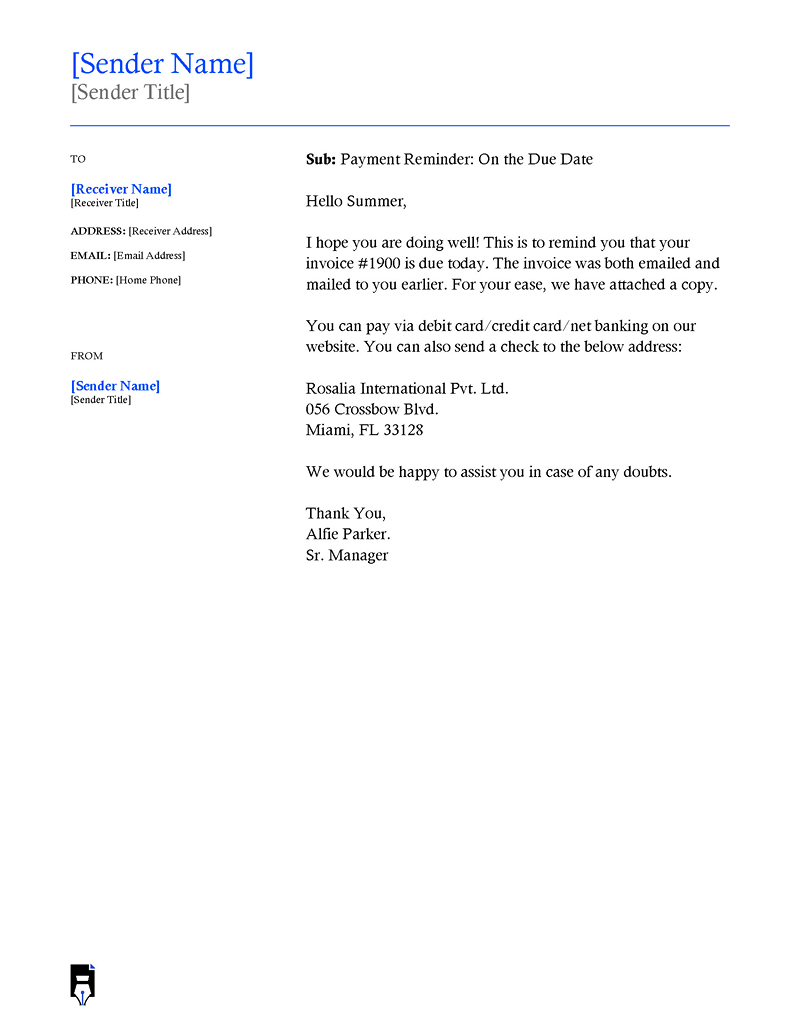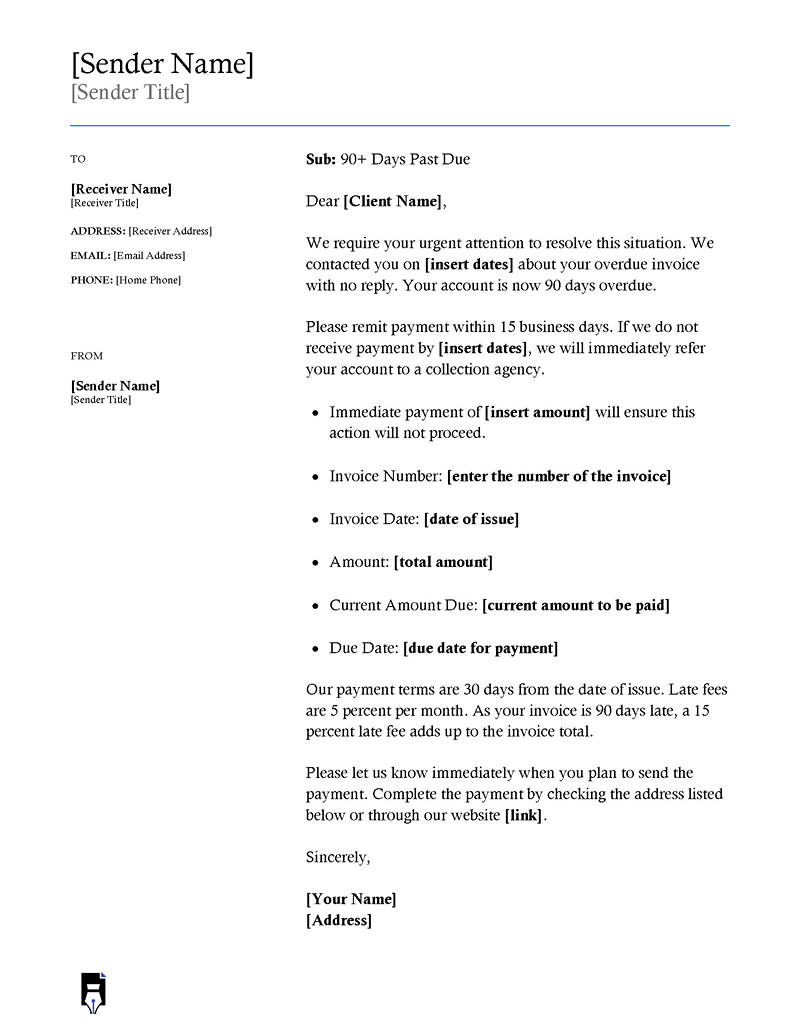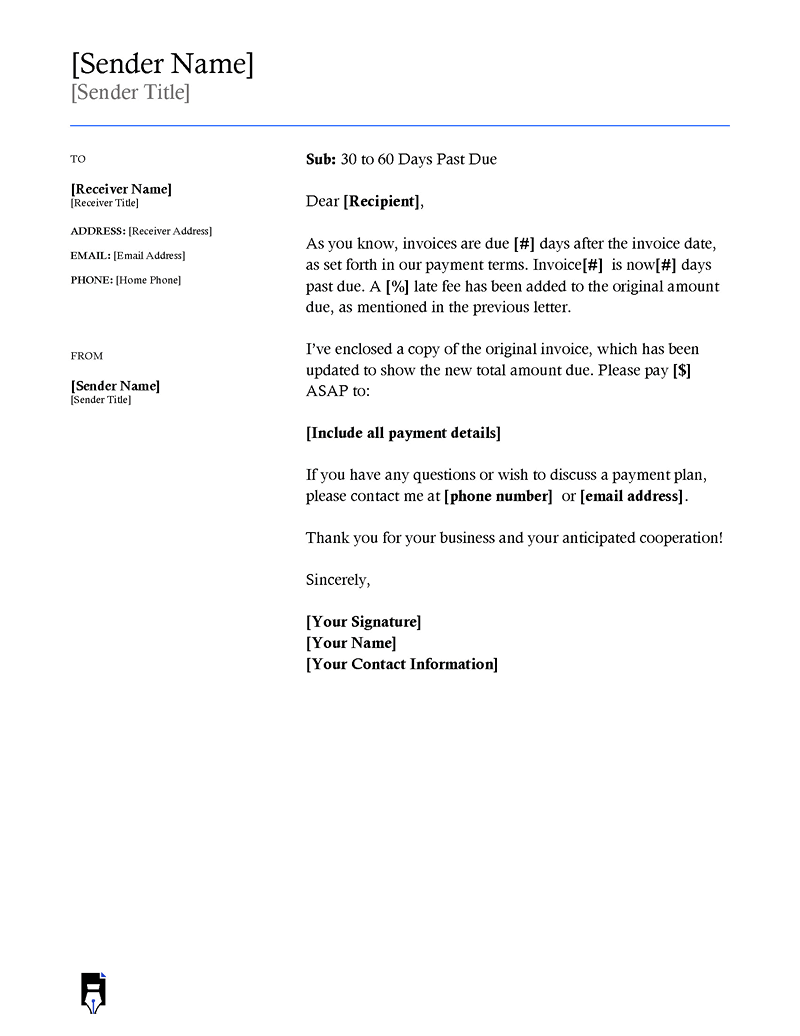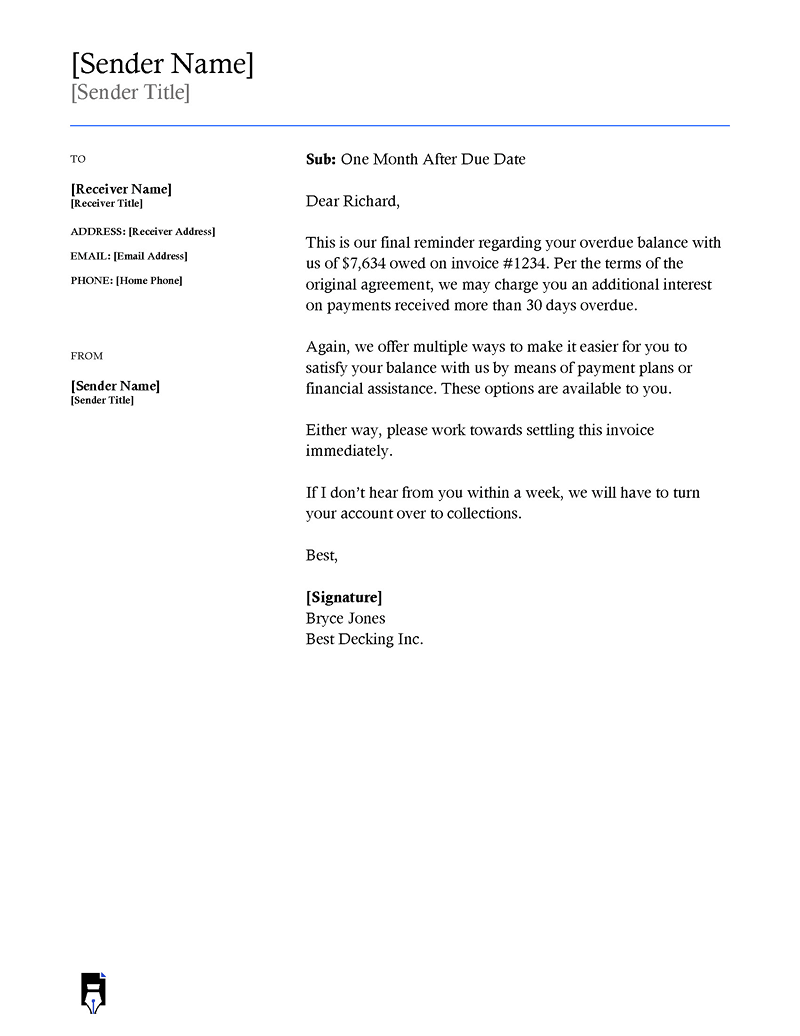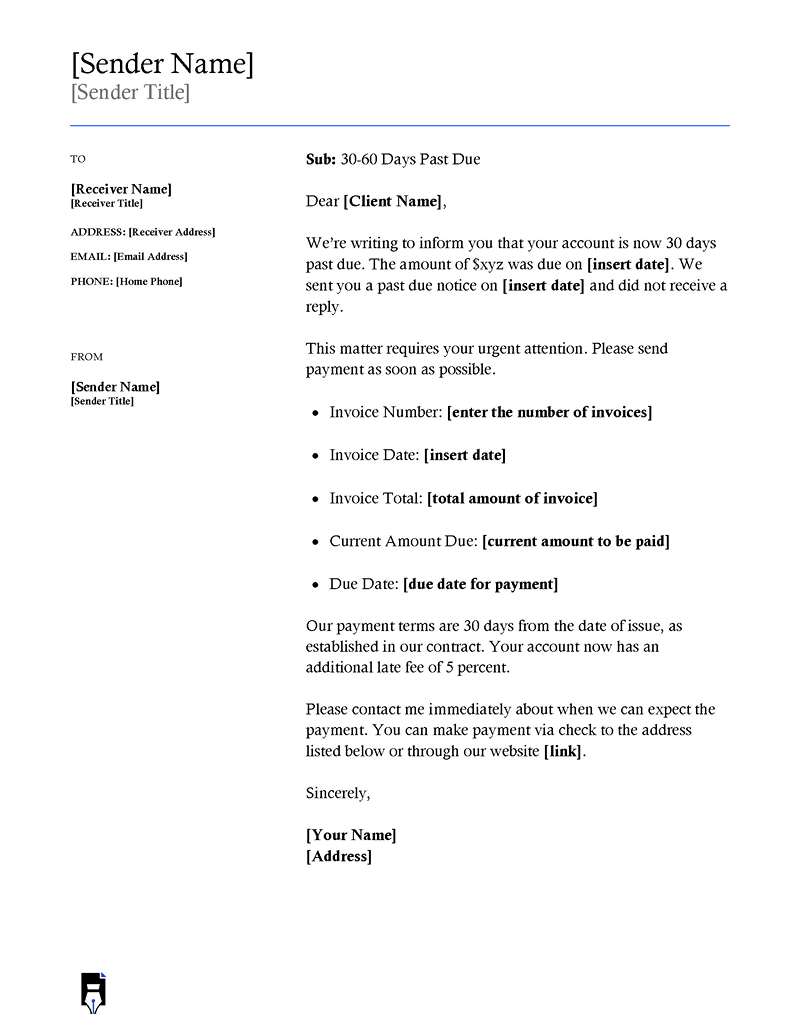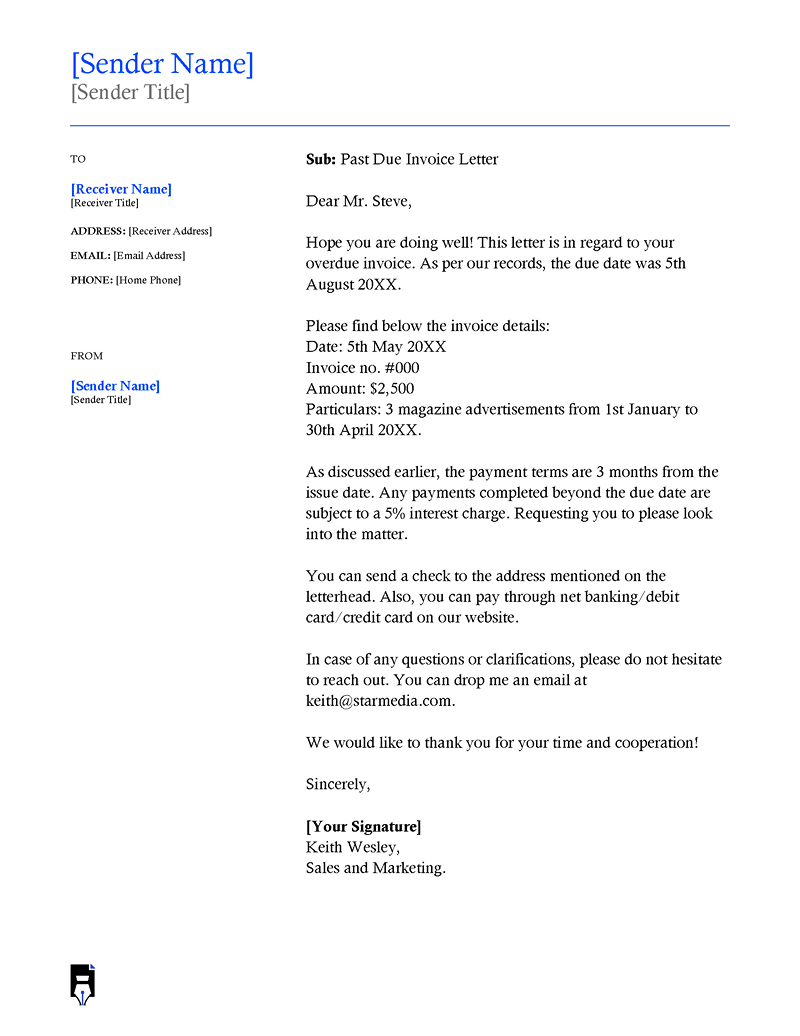A past due letter is a due invoice that businesses send to customers after an invoice has been sent, but no payment has been received by the stipulated due date.
This letter functions as a reminder of the debt and requests the payment or some explanation to be made. The letter is alternatively known as an overdue invoice letter or past due notice. Ordinarily, most professionals send notices as emails since they are faster and offer proper documentation of the correspondence between the seller and the customer. However, you can issue the notice through a physical letter or a phone call.
Download Free Templates
You can use templates to write a past-due invoice letter. Templates guide you on which information to include in the letter and how to properly organize its sections to communicate your message and intent effectively. This saves you time and effort to create an excellent past-due notice from scratch. Our readers can access such templates from our site at no cost. In addition, the templates are readily downloadable and easy to customize to suit your specific needs.
General Overview
At times, clients fail to make payments before the due date of an invoice. Such delays or defaults can lead to serious cash flow problems. You, therefore, have to reach out to such clients and find a way to resolve the overdue invoice. A past-due invoice letter is one of the interventions utilized in this exercise. The letter indicates the debt owed, references the overdue invoice, and clarifies your late payment policies and possible consequences.
For example, customers will miss payments because they either forgot the due date or cannot pay. An overdue invoice letter clarifies the matter before pursuing any other excessive intervention, such as legal action.
Past overdue invoice notices can be used in any industry, including freelance and contracting. The letter is a professional intervention and helps you avoid excessive confrontations that can damage your client relationship while requesting prompt payment. This is highly important because as the number of days past the due date increase, the higher the probability of the invoice not getting paid.
This article will teach you how to write an influential past-due invoice letter, when to use one, and tips to help you collect debts with the help of the letter.
When to Start Sending Past Due Notice Letters?
The notice can be sent at different intervals past the due date. Primarily, the letter should be issued if other interventions, such as email or phone calls to collect the payment, have failed. This is because the letter is deemed a more official intervention and holds more weight than previous interventions.
There is no specific point when you should send the letter. It should be at your discretion and based on your payment reminder strategy. However, there are different ways to phrase your letter depending on how many days after the due date you are sending the letter.
Below are how past-due invoice letters differ based on the number of days:
1-15 days past due
Use a friendly and polite tone in the letter. This will typically be the first reminder, so ensure that the customer knows it is a reminder, not a warning. You should be focused on preserving your relationship with the customer. Guide them about the payment by outlining the payment terms.
Also, ask them to acknowledge whether they have received the letter and respond to it. You should also call them once they have received the letter, as conversing with them personally can provide further clarification. If the client cannot pay, still allow them to explain. If you do not receive any response from them after this letter, move to the next stage.
30-60 days past due
You should send a follow-up letter if payment has not been made 30 days after the due date. The letter should be written professionally and indicate the issue’s urgency. In this letter, be more affirmative in asking for the payment. You should attach a copy of the invoice and indicate the new amount owed, including any applicable late fees. Also, mention that you had already sent them an invoice and a reminder and did not get any response.
90+ days past due
If the customer does not settle their accounts after 90 days past the due date, there is a probability they will not be paying the amount owed. Therefore, the letter you sent past 90 days should be more of a warning giving the client a final chance to settle their debt. Such a letter should include a new due date. In the letter, indicate that non-payment is a breach of agreement, and you may have to take legal action.
How to Craft a Past Due Invoice Letter
A past-due invoice letter is a formal correspondence that has to be carefully and correctly formatted and structured to ensure it serves its purpose.
Below are the steps to write a compelling past-due invoice letter:
Step 1: State the purpose of the letter
You should begin your letter by addressing the recipient. This is done by indicating the recipient’s name and a polite greeting. Then state the letter’s purpose. The letter’s purpose is to notify the client of the past due invoice and request them to pay the outstanding amount. Be professional, polite, and friendly with your wording and tone. You should focus on making the debt the main subject of the sentence, not the client. This prevents the client from being defensive or embarrassed about the debt.
For Example:
This notice reminds you of the outstanding payment from the previously issued invoice.
Step 2: Include all invoice and overdue payment details
The following section should capture details regarding the overdue invoice and other payment details. You should reference the overdue invoice by indicating your name, the invoice number, the amount owed, the original invoice due date, and the date of issuance. This helps the client remember the payment they had forgotten and helps them search the document through their files.
Also, clarify the payment methods available to the customer. You can offer them options such as cash or credit card or direct them to a payment page.
This section can be structured as follows:
This letter is about Invoice Number 22-09-27-BGT, which was sent on 22 September 2022. The outstanding amount is $521.60, due on 5 October 2022. Payments can be made at 28 Balk 10 Queen St, Minneapolis, MN 1234 or Bank account 568-8769 at a US bank via internet banking or on our website: www.beegetoyscompanies.com.
Step 3: Remind the client of your late payment policies and penalties
You should then specify any applicable late payment policies and the penalties imposed on the debt. Late fees can be a percentage of the amount owed or fixed. Before engaging with them in any business, these policies should always be discussed with the client. So, it is always advisable to include the late fee terms in the contract.
In some states, late fee policies may be subject to state laws, so you should remain compliant. For example, if your state’s annual interest rate for late fees is 20%, divide by 12 to discover the monthly interest rate you can charge, which is equivalent to 1.6% per month.
For Example:
In accordance with our payment policies, if payment is not received within 30 days after billing, a late fee of $50 will be added to each invoice. Therefore, the current late fee charge is $50 making the total amount owed 571.60.
Step 4: Offer to resend the invoice
Next, offer to resend the invoice if the client has misplaced the original document. Alternatively, attach a copy of the invoice. Send the copy in a PDF format which is more reader-friendly. You can also offer any other assistance that can expedite the payment process.
For Example:
I have enclosed a copy of the invoice for your convenience. I hope this will refresh your mind and help expedite the payment process.
Step 5: Offer a payment plan
If the client has difficulty settling the debt, offer them an option to pay in instalments. You can also pursue this option for customers who do not respond to reminders. Outline the structure of the payment plan in this section of the past-due invoice letter. Use a mutually convenient plan. This can help prevent legal action and ensure you get paid in the long run.
For example, you can structure this section as follows:
If you cannot repay the total amount at once, we will consider a payment plan of $50 weekly for six weeks. Payments will be expected every Friday of the week. This payment plan commences this coming week, on 17 October 2022.
Step 6: Add your availability to answer questions
In this section, add your availability to answer questions or address concerns. You can also state that you will be following up with the client. This acts as an invitation to discuss the past-due invoice. It can also prompt them to act quickly as they know you are willing to seek payment actively.
For Example:
I am available at 812-256-5000 between 1:00 PM and 5:00 PM on Monday to Friday if you have further questions regarding the payment plan or your invoice. I will be calling next should this letter go unanswered.
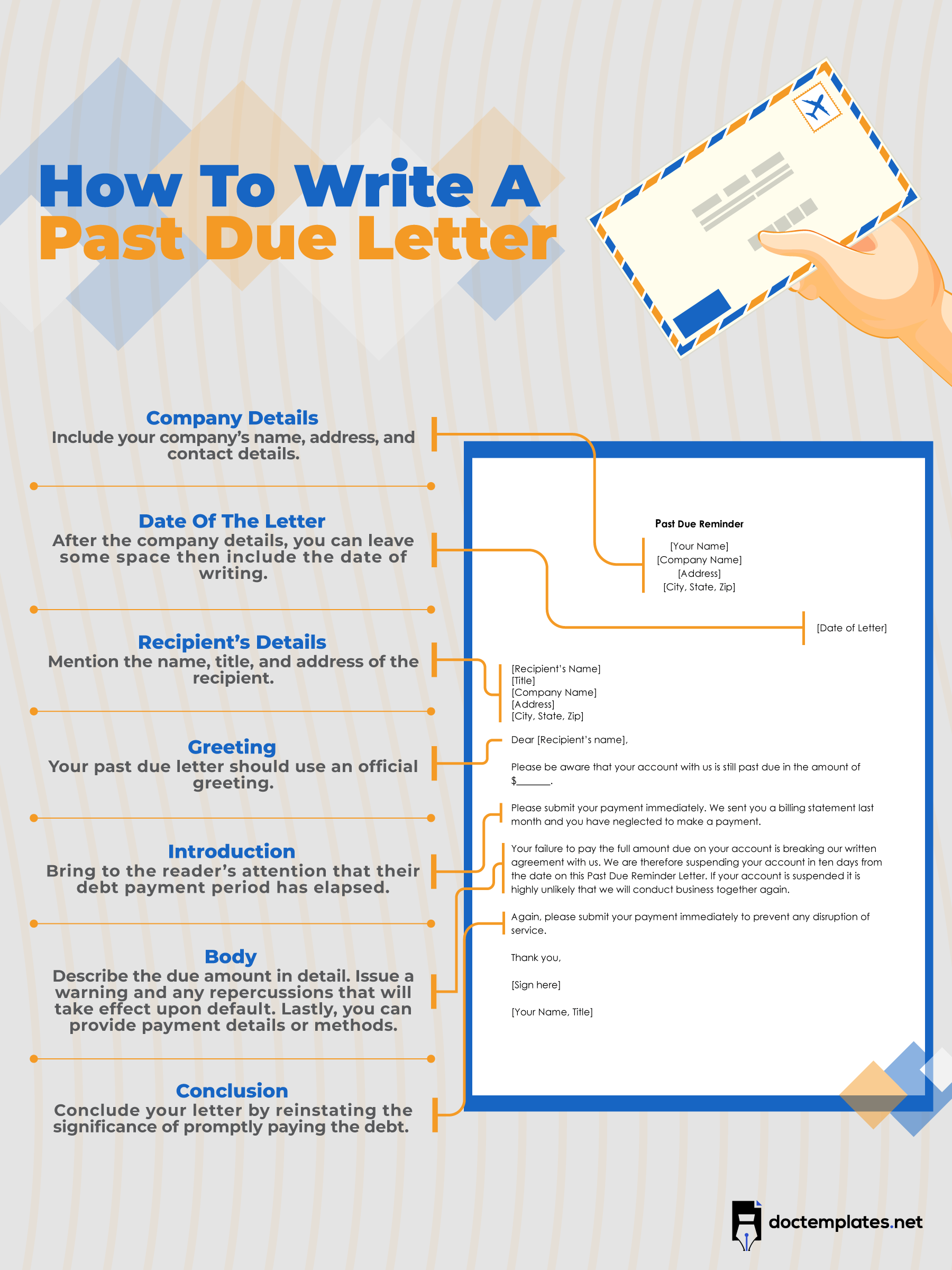
8 Tips to Write and Send Past Due Letter
A past-due invoice letter to the client is a serious step in any transaction as it can lead to legal action, affecting your business’s cash flow. However, doing so also has benefits, such as receiving payment and avoiding losing business. So, you need to undertake this process correctly and as effectively as possible.
Here are some tips to follow before writing and sending the letter:
Send it promptly
The earlier you send the past-due invoice letter, the more likely you will receive payment. So timing is essential. You should send an email as a reminder a few days before the due date and another one immediately after they miss the due date. Be persistent in your pursuit of payment and ensure any grace period elapses before sending a past-due notice.
Change your tone depending on the time frame
You can treat letters differently depending on whether the invoice is over a few days late, 30 days, more than 30 days, or any other. As the number of days increases, so should the firmness in your tone. If the payment is late by a day, use a more friendly tone. However, if the payment is 90 days late, let the client know they must pay promptly and include the days to clear the debt.
Tailor your language
The language used in the letter should be professional and polite. However, as the number of days passed increases, adjust your language to exude more authority. Use words and phrases that show your precise intentions to collect the payment. Also, tailor your language to suit your relationship with the client.
Provide online payment options
Include online payment options when outlining the different payment methods the client can use. Online payment methods can be more convenient for the client and quicker than check and cash payments.
Don’t miss out any details
Include any information to help the client identify the payment and avoid misunderstandings later. However, do not include inaccuracies and mistakes. Also, do not add any irrelevant information. If you do, it will confuse the client further and decrease their chances of paying the agreed amount on time. Some details include your name and contact details, invoice number, issuance date, the amount owed, invoice particulars, payment terms, and methods.
Adjust your language
You should adjust your language based on the situation. The language used for the first reminder should be different from that of the third. Also, use certain words and phrases to communicate your intentions in different sections of the past-due invoice letter.
For example:
-For late payments by a few days, use phrases like “for your convenience” and “for your ease.” Also, incorporate words such as – kindly, please, thank you, we appreciate, requesting you, etc.
-When asking for payment, use phrases such as “urgent matter,” “immediate attention,” “action required,” etc.
-To remind the client of previous interactions, use words such as “As you know,” “As we discussed earlier,” or “As discussed on the call.”
However, you should remain professional throughout the letter. Adjust your tone and language according to whether the client is being somewhat unreasonable in their payment or is being thoroughly uncooperative.
Follow up proactively
You should pursue the debt proactively. Make calls to the client when necessary. Use email, calls, and letters as needed. Send regular reminders; the typical intervals for most businesses are 30, 45, 60, and 90 days. Do not wait for the client to request or ask for a call. Instead, set appointments and follow up after they miss the payment.
Automate reminders
With current advanced technology, you do not have to think about when you should contact, who you should contact, or how you should do so. It is possible to send out automatic reminders to follow up on past-due notices with customers or clients. You can automate printing and sending past-due notices. You can also set reminders for when specific invoices are due – for example, set the system to send a reminder after 1, 15, 30, 45, 60, and 90 days past the due date.
Key Takeaways
- You must be strategic when issuing past-due invoice letters, as it will increase the chance of receiving payment and avoid loss of business. In addition, no standard debt collection process applies to all businesses or industries, so you need to develop one that fits the needs of your business in particular.
- If a client has a history of being late on payments, you should consider that when sending out your following letter. You can adjust the tone and language to suit the severity of the case.
- Before imposing late fees, check your state laws on late fees. For example, some states limit how much you can charge your clients as late fees.
- Note that not all clients have to be charged late fees. Some clients have genuine reasons for not paying. You should thus handle each client on a case-by-case basis and formulate mutually convenient payment plans.
- You should always aim to protect your relationship with the customer. Remain professional and polite even when the client is uncooperative. However, be firm and relentless in seeking payment.
